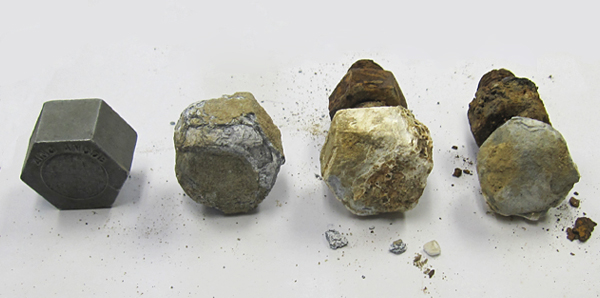Zinc Anode Caps are threaded end caps, shaped like hex nuts, which are fastened to the ends of bolts or studs on a buried pipeline or related pipeline component.
What is their purpose?
The zinc in an Anode Cap sacrificially corrodes before the steel of the fasteners, fittings or related components, which helps protect these items, thus extending their life and preventing possible damage from failed fasteners.
How do they work?
Corrosion attacks almost every metal component in the environment. For a buried installation, such as a pipeline, “normal” corrosion causes a loss of iron from a component, such as a steel fastener, by means of “rusting”, as a chemical reaction takes place with the moisture in the soil. Metal can also be lost in a phenomenon called GALVANIC CORROSION.
Each metal has an electochemical potential which can be found on published charts of the Galvanic Series. The more “active” metals are ANODIC, the less active ones are CATHODIC. When two dissimilar metals are in contact in the presence of an ELECTROLYTE (such as moisture in the soil), the anodic metal corrodes more than the cathodic, in an electrochemical interaction.
Common household examples of this galvanic corrosion include the following:
- Old batteries inside a forgotten flashlight or other portable electronic device typically have an exterior surface which shows the pitting and corrosion products indicative of a GALVANIC CELL. The outside case is a zinc alloy and is the “anode” (negative); it is actually being “consumed” by the “cathode”, which is the carbon post at the center of the battery (positive); both are in contact with a metallic compound which is the electrolyte.
- A wet scouring pad of steel wool left on the surface of a stainless steel sink quickly begins to rust, as the pad becomes an anode to the sink’s cathode in contact with the moisture (electolyte) remaining in the pad.
How are they used?
In a pipeline, these same corrosive processes are at work, especially at the joints with fasteners. The dissimilar metals will constitute a galvanic cell and begin the damage almost immediately. Even though the fasteners and fittings may be in the same grouping on the Galvanic Series Chart, their relative electrochemical difference will set up a galvanic cell and its preferential corrosion. The addition of the Zinc Anode Caps to the fasteners protects the components by corroding at a much higher rate than iron, even reducing the normal corrosion rate of the protected components.
The image below shows a new Zinc Anode Cap next to caps taken from actual appications. The cap on the stud at center has protected it from corrosion; the far right cap is almost consumed but still absorbing most of the corrosion (debris on the hex nut masks the lack of damage).

How do you choose or specify Zinc Anode Caps?
For use in buried pipelines, the Anode Caps must be made from a very high grade of zinc. In fact, the zinc must be at least 99.99% pure zinc. It is quite possible for lower purity Zinc Anode Caps to lose their protective abilities by becoming “passive” in the application.
What standards apply to Zinc Anode Caps?
The reference Standards most used for Zinc Anode Caps are the following:
ASTM B 418 Standard Specification for Cast and Wrought Galvanic Zinc Anodes (the current revision is the -12 update).
ASTM B 418 requires the following:
“5. Chemical Composition
5.1 The anode shall be made from Special High Grade zinc conforming to Specification B 6, with suitable alloying additions for Type I anodes.”
ASTM B 6 – 06 Standard Specification for Zinc.
This specification sets the Chemical Requirements for Special High-Grade Zinc.
ASTM B 6, Table 1 Chemical Requirements, requires the SPECIAL HIGH GRADE (SHG) have a minimum zinc content of 99.990%, along with limits on the maximum percentages of other elements. (As a note, even 99.990% zinc Anode Caps can become passive if their trace element content, such as iron, exceeds the maximum allowable. When an anode becomes PASSIVE, it will fail to provide the sacrificial corrosion protection desired, allowing corrosion of the other components instead.)
MIL-A-18001K Military Specification – Anodes, Sacrificial Zinc Alloy (with interim amendment 3), dated 24 October 2007.
This specification is sometimes cited, but it does not specifically address Zinc Anode Caps.
Do Trumbull Zinc Anode Caps meet these Standard Specifications?
Trumbull Zinc Anode Caps DO meet these requirements. The chemical analyses of production batches are routinely tested and certifications are available.
What sizes are available?
Trumbull Zinc Anode Caps are available in 2.5 ounces and 6 ounces sizes.
How many do I need?
There are two answers to that question:
- The first answer, and the most obvious, is to use an Anode Cap on each bolt or stud on the joint or fitting; and those caps should be the large size. This answer is based upon the fact that the Anode Cap is a consumable, and will continue protecting until the zinc is used up. It is also the least expensive component of the application. (As an interesting note, on the Galvanic Chart cast iron and carbon steel are more galvanically active than T304 and T316 stainless steel. This means that the use of fasteners of these stainless steels can actually cause the iron and carbon steel components of the pipeline to become the sacrificial anodes, and corrode preferentially to the fasteners. This is the cause of the rusting explained previously of the scouring pad on the stainless steel sink.)
- The second answer is more technical, requiring much more detail than can be provided here. A short version is that a Zinc Anode Cap meeting the specifications noted above contains a usable energy content of 353 ampere-hours per pound, theoretically, (at a typical efficiency of 95%). The useful life hours depend upon, of course, the metal being protected, and the electrolyte value of the backfill. Being able to calculate the “life” of the protection would permit an estimate of when to perform a trial inspection of a typical joint in the pipeline, to gage the actual effects of corrosion.
Meaning of H-20
The American Association of State Highway and Transportation Officials developed a standard, M306 that calls for proof load testing for iron castings. For an H-20 proof load test, that standard requires a 40,000 lb. load be applied to a 9” x 9” square plate for one minute. Any cracks or permanent deformation greater than 1/8” are cause for rejection.
What is “Lead Free?”
As of January 4, 2014, the Reduction of Lead in Drinking Water Act (RLDWA) changed the allowable lead free content definition in Section 1417 of the Safe Drinking Water Act (SDWA) to a weighted average of not more than 0.25 percent lead, with respect to the wetted surfaces of pipes, fittings, valves and other fixtures. These are Federal regulations.
SLENDERNESS RATIO
This ratio is the unsupported length of the extension stem, divided by the “radius of gyration” of the stem cross section. The unsupported length is the distance between the extension stem Operating Nut and the Bottom Coupling, or when stem guides are used, the longest distance between any two “supports.” It is typically used to determine the susceptibility of a column to buckling.





